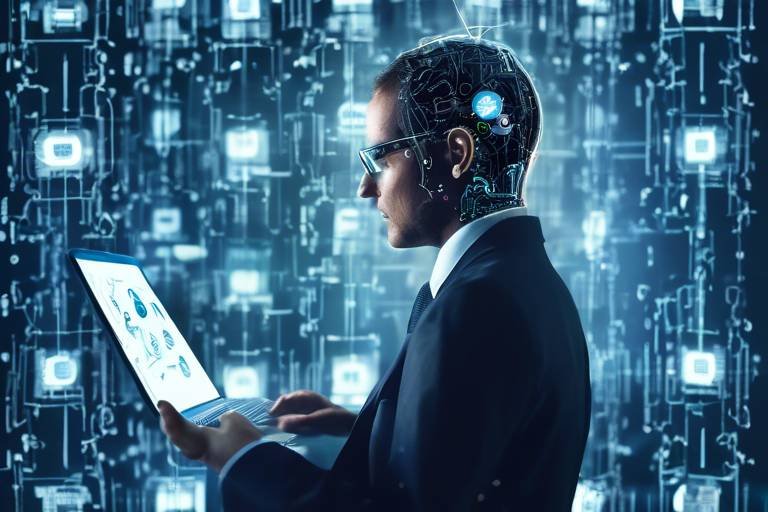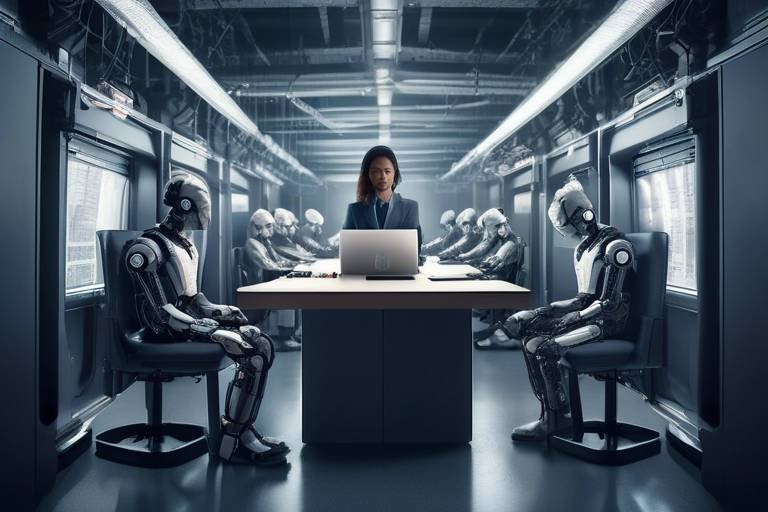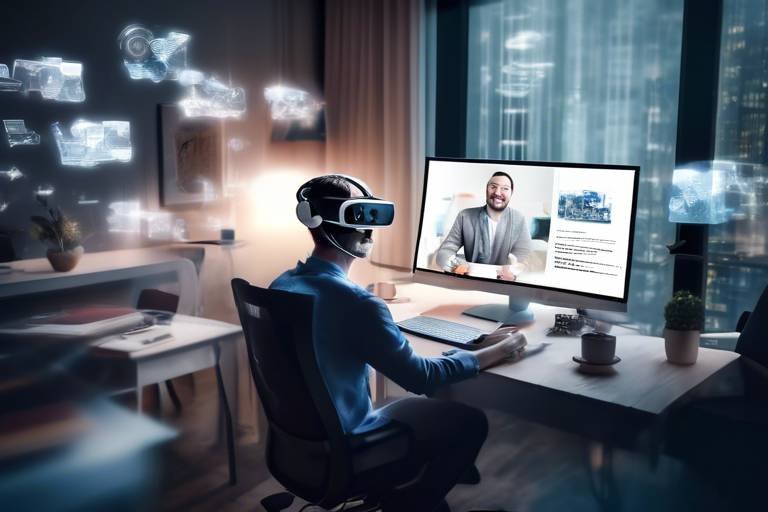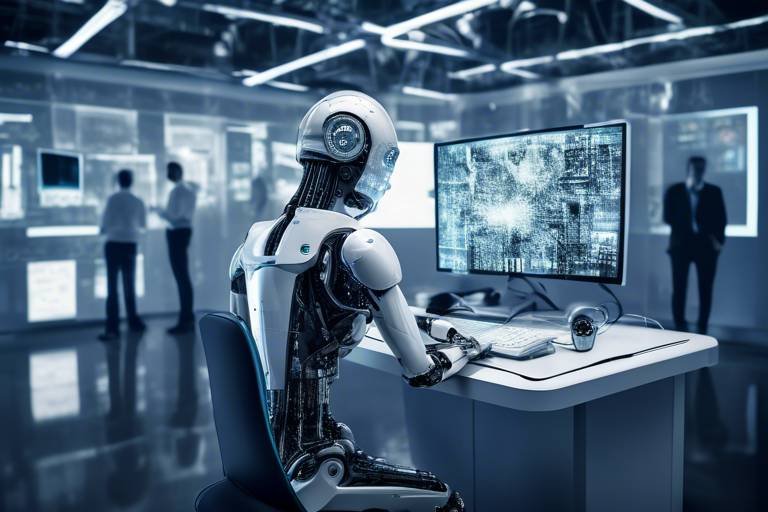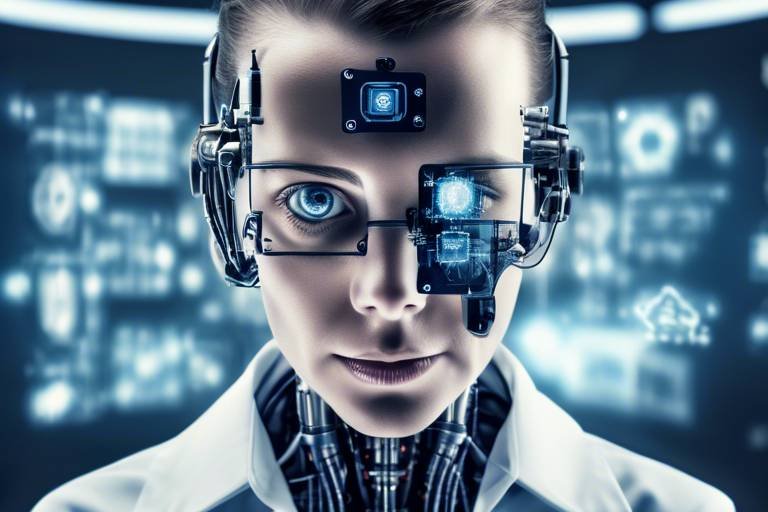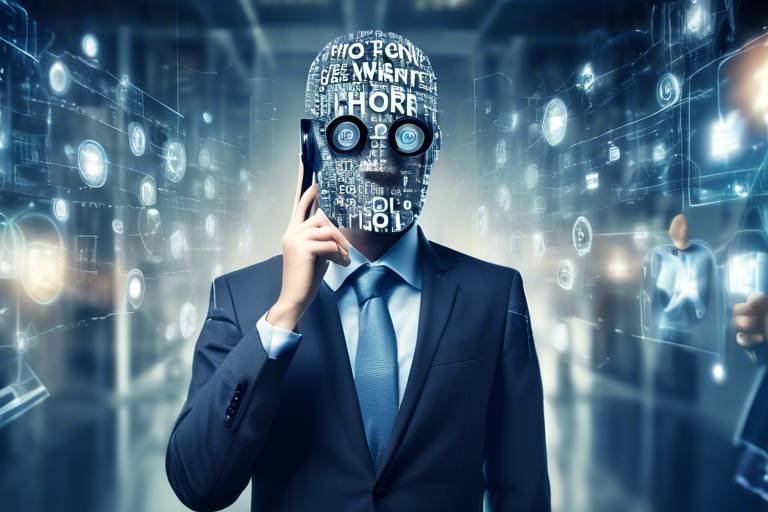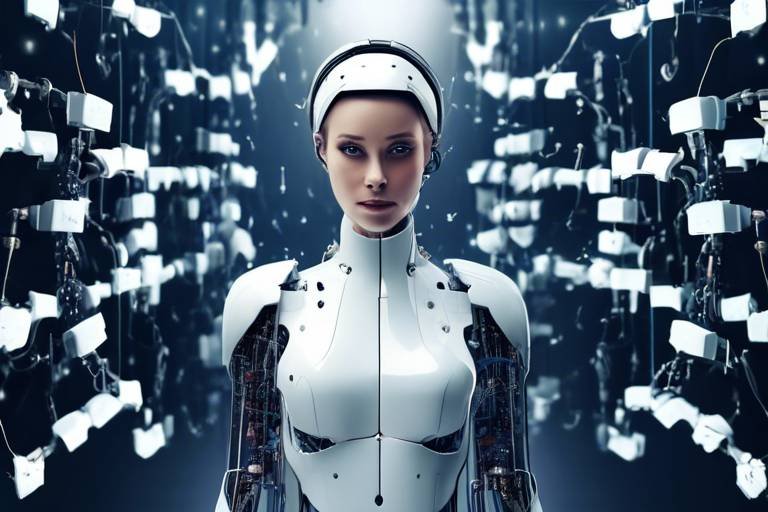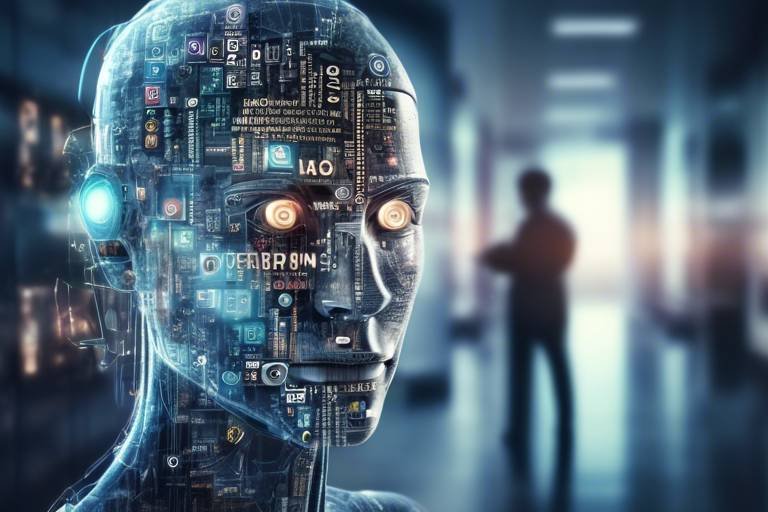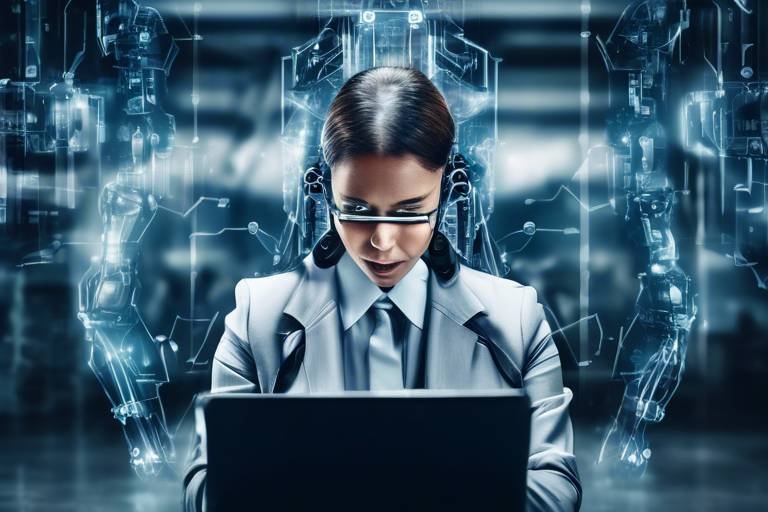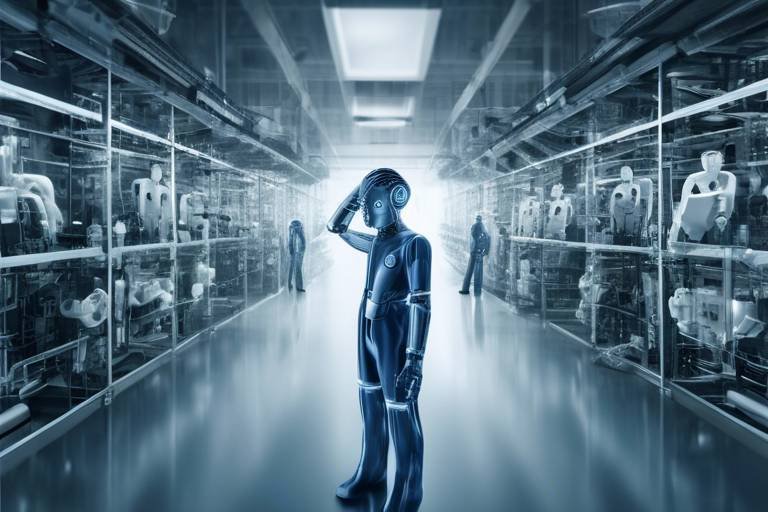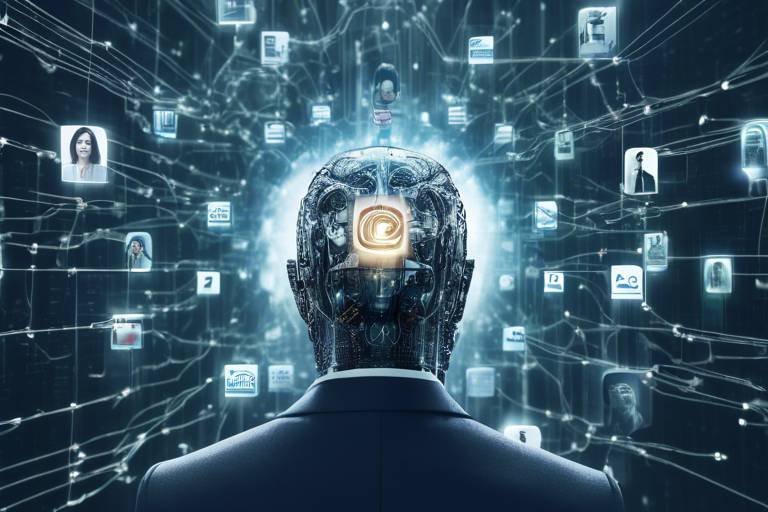Making AI Work: Navigating the Future of Employment
In today's rapidly evolving technological landscape, the impact of artificial intelligence (AI) on the workforce cannot be overstated. As we stand on the brink of a new era, the integration of AI into various sectors is not just a trend; it’s a revolution that is reshaping how we work, interact, and even think about employment. But what does this mean for you, the worker? Are we heading towards a dystopian future where machines replace human jobs, or are we on the verge of unlocking unprecedented opportunities? This article dives deep into the challenges and opportunities presented by AI, aiming to equip you with the knowledge to navigate this brave new world.
As AI technology continues to advance, its integration into various industries is reshaping job roles and responsibilities, prompting both excitement and concern among employees and employers alike. Imagine walking into an office where your tasks are partially handled by machines, freeing you to focus on more creative and strategic endeavors. Sounds appealing, right? However, this shift also raises questions about job security and the need for new skills. The reality is, we are witnessing a paradigm shift in how work is conceptualized and executed. From predictive analytics in marketing to automation in manufacturing, AI is becoming an integral part of the workplace.
While AI threatens certain jobs, it also opens up new opportunities. This duality creates a complex landscape where some roles may vanish, but others will emerge, often in areas we can't yet imagine. For instance, AI can take over repetitive tasks, but in doing so, it often creates a demand for roles that require human creativity and emotional intelligence. This section analyzes the balance between roles lost and those created by emerging technologies, highlighting the importance of adaptability in the workforce.
Different sectors experience varying levels of disruption from AI. Here, we explore which industries are most vulnerable and which are poised for growth due to technological advancements. For example, the manufacturing sector is seeing a major transformation, but healthcare is also undergoing a significant evolution. Let's break it down:
Manufacturing is undergoing a significant transformation with automation, leading to increased efficiency but also raising concerns about job security for workers in this sector. Automated systems can handle tasks faster and with greater precision, but they also require a workforce skilled in managing and maintaining these technologies. It’s a double-edged sword: while machines take over mundane tasks, they also create a need for skilled technicians and engineers.
AI is revolutionizing healthcare by enhancing diagnostics and patient care, creating new roles for healthcare professionals while changing the nature of existing jobs. Imagine a world where AI can analyze medical data faster than any human, allowing doctors to focus on patient interaction and care. This shift not only makes healthcare more efficient but also improves patient outcomes. However, it necessitates that healthcare workers adapt to new technologies and workflows.
As AI reshapes the job landscape, specific skills become increasingly valuable. Workers will need to develop a blend of technical and soft skills to thrive in an AI-enhanced workplace. Skills such as data analysis, machine learning comprehension, and emotional intelligence will be crucial. In addition, the ability to work alongside AI systems will become a sought-after competency. Continuous learning and adaptability will be key to staying relevant in this dynamic environment.
To remain competitive, organizations must invest in reskilling and upskilling their workforce. This section highlights successful programs and strategies for employee development in the age of AI. Companies that prioritize training will not only retain top talent but also cultivate a more innovative and resilient workforce.
Companies are implementing innovative training programs to equip employees with necessary skills. For instance, tech giants are offering workshops on AI literacy, while traditional industries are partnering with educational institutions to develop tailored training modules. We examine case studies of organizations that have successfully embraced this approach, showcasing the benefits of investing in human capital.
Governments and educational institutions play a crucial role in preparing the workforce for AI integration. Collaborative efforts aimed at fostering a future-ready workforce are essential. For example, initiatives that promote STEM education and vocational training can help bridge the skills gap. By aligning educational outcomes with industry needs, we can create a workforce that is not only equipped to handle current demands but also agile enough to adapt to future changes.
The rise of AI brings ethical considerations regarding fairness, bias, and transparency in hiring practices. Companies must navigate these challenges carefully to maintain trust and integrity in their operations. This section delves into the moral responsibilities of companies utilizing AI technologies.
AI systems can perpetuate existing biases, impacting hiring and promotion decisions. For instance, if an AI is trained on historical data that reflects societal biases, it may inadvertently favor certain demographics over others. We explore the challenges of ensuring fairness in AI-driven processes and potential solutions, such as implementing rigorous testing and validation protocols.
Establishing transparency in AI applications is essential for building trust. Organizations must be accountable for the decisions made by their AI systems, ensuring that stakeholders understand how and why decisions are made. This section discusses the importance of accountability in AI decision-making within the workplace, emphasizing that transparency can mitigate fears and foster a culture of trust.
Looking ahead, we analyze emerging trends that will shape the future of work. AI will continue to influence employment dynamics and organizational structures, leading to more flexible and remote work environments. As automation becomes more prevalent, roles will evolve, and new job categories will emerge, often in ways we can't yet predict. The future is not just about machines taking over; it’s about humans and AI working together to create a more efficient and innovative workforce.
- Will AI really replace my job? - While AI may automate certain tasks, it will also create new roles that require human skills.
- What skills should I focus on to stay relevant? - Focus on developing technical skills related to AI and data analysis, as well as soft skills like communication and problem-solving.
- How can companies ensure ethical use of AI? - Companies should implement guidelines for transparency, accountability, and regular audits of their AI systems to minimize bias.
- What role do educational institutions play in this transition? - Educational institutions must adapt their curricula to include AI literacy and relevant technical training to prepare future workers.

The Rise of AI in the Workplace
As we stand on the brink of a technological revolution, the rise of artificial intelligence (AI) in the workplace is not just a trend; it's a seismic shift that’s altering how we work, interact, and even think about our careers. Imagine a world where mundane tasks are automated, allowing employees to focus on more creative and strategic endeavors. Sounds appealing, right? Yet, this transformation brings with it a mix of excitement and trepidation that echoes through boardrooms and break rooms alike.
The integration of AI technologies is reshaping job roles across various industries, prompting a reevaluation of what it means to be employed in the modern economy. From chatbots handling customer service inquiries to sophisticated algorithms analyzing data for actionable insights, AI is becoming the backbone of many operational processes. In fact, a recent study showed that over 70% of companies are already utilizing some form of AI in their operations, and this number is only expected to grow.
But what does this mean for the workforce? On one hand, there’s a palpable sense of fear surrounding job displacement. Many employees worry that machines will take over their roles, leaving them obsolete in a world that increasingly values efficiency over human touch. On the other hand, we must also consider the opportunities that AI presents. New job categories are emerging, ones that didn’t even exist a decade ago, such as AI ethics compliance officers and machine learning specialists. In essence, while AI might replace some jobs, it’s also paving the way for new roles that require a different set of skills.
To illustrate this point, let’s take a look at a few key statistics:
| Impact of AI on Employment | Percentage of Jobs Affected |
|---|---|
| Jobs at Risk of Automation | 40% |
| New Jobs Created in AI Sector | 30% |
| Jobs Requiring Reskilling | 60% |
As we navigate this uncharted territory, it’s essential to focus on how we can adapt and thrive in this AI-driven environment. Organizations are beginning to realize that they must not only embrace AI but also invest in their employees' growth and development. This means fostering a culture of continuous learning and encouraging adaptability among their teams. After all, in a world where change is the only constant, being a lifelong learner is a skill that will always be in demand.
So, what’s the takeaway here? The rise of AI in the workplace is a double-edged sword. It’s a powerful tool that can enhance productivity and create new opportunities, but it also poses challenges that we must face head-on. By embracing change and focusing on upskilling, we can ensure that the workforce of the future is not just surviving but thriving in this exciting new landscape.
- What industries are most affected by AI? Industries such as manufacturing, healthcare, and finance are experiencing significant changes due to AI integration.
- Will AI take away all jobs? While AI may automate certain tasks, it will also create new job opportunities that require human skills and creativity.
- How can employees prepare for an AI-driven workplace? Employees can prepare by engaging in continuous learning and acquiring new skills that complement AI technologies.

Job Displacement vs. Job Creation
The advent of artificial intelligence (AI) has sparked a heated debate about its impact on employment. On one hand, there is a palpable fear of **job displacement**; on the other, an undeniable potential for **job creation**. As we navigate this complex landscape, it's crucial to understand that these two forces are intertwined rather than mutually exclusive. The reality is that while some jobs may vanish, new ones will emerge, often in roles we haven’t even imagined yet.
To illustrate this dynamic, consider the following: as AI takes over repetitive and mundane tasks, it frees up human workers to focus on more creative, strategic, and interpersonal aspects of their jobs. This shift can lead to greater job satisfaction and productivity. For instance, a factory worker may find themselves transitioning from assembly line duties to roles in quality control or process optimization, utilizing their insights to improve efficiency.
However, not all industries will experience this transition equally. Some sectors are more vulnerable to job losses due to automation, while others may thrive. According to recent studies, the following industries are expected to face significant changes:
| Industry | Impact of AI |
|---|---|
| Manufacturing | High job displacement, low job creation |
| Healthcare | Moderate job displacement, high job creation |
| Retail | High job displacement, moderate job creation |
| Information Technology | Low job displacement, high job creation |
As shown in the table, the **manufacturing sector** is particularly vulnerable, with many roles being replaced by robots and automated systems. Conversely, the **healthcare industry** is experiencing a surge in new job opportunities, as AI enhances diagnostics and patient care, leading to the need for more skilled professionals.
Moreover, it’s essential to recognize that the skills required in the job market are evolving. As AI takes over more routine tasks, workers will need to adapt by developing new competencies. Skills such as critical thinking, emotional intelligence, and creativity are becoming increasingly valuable. This shift emphasizes the importance of **reskilling** and **upskilling** initiatives, which will be crucial for individuals looking to thrive in an AI-enhanced workplace.
In conclusion, while the fear of job displacement is valid, it’s equally important to acknowledge the potential for job creation that AI brings. By embracing change and investing in personal and professional development, workers can navigate this evolving landscape and seize new opportunities. The future of work may be uncertain, but with the right mindset and skills, it can also be incredibly promising.
- Will AI completely take over all jobs?
No, while AI will automate certain tasks, it will also create new jobs that require human skills. - What skills should I focus on to stay relevant in the job market?
Focus on developing skills like critical thinking, creativity, and emotional intelligence, which are less likely to be automated. - How can companies help their employees transition to new roles?
Companies can implement reskilling and upskilling programs to equip employees with the necessary skills for emerging job roles.

Industries Most Affected
As we delve into the world of artificial intelligence, it's crucial to recognize that not all industries are created equal when it comes to the impact of AI integration. Some sectors are experiencing a seismic shift, while others are merely feeling a gentle tremor. Manufacturing, healthcare, retail, and finance are among the industries most affected by AI advancements, each facing unique challenges and opportunities that can reshape their workforce dynamics.
In the manufacturing sector, the rise of automation is akin to a double-edged sword. On one hand, robots and AI systems streamline production processes, leading to enhanced efficiency and reduced costs. On the other hand, this automation poses a significant threat to traditional manufacturing jobs. Workers who once operated machinery may find themselves replaced by intelligent systems capable of performing tasks with greater precision and speed. However, it's essential to note that while some jobs may vanish, new roles focused on managing and maintaining these advanced technologies are emerging.
Healthcare is another field undergoing a transformative revolution due to AI. Imagine a world where diagnostic processes are faster and more accurate, thanks to machine learning algorithms analyzing patient data. This innovation not only improves patient outcomes but also creates new job opportunities for healthcare professionals. Roles such as AI healthcare specialists and data analysts are becoming increasingly vital, highlighting the need for medical workers to adapt and evolve alongside technological advancements.
Retail is not exempt from the AI wave either. With the rise of e-commerce, traditional brick-and-mortar stores are rethinking their strategies. AI-driven analytics allow retailers to understand consumer behavior better, personalize shopping experiences, and optimize inventory management. While this could lead to job losses in physical retail spaces, it also creates demand for positions in digital marketing, data analysis, and supply chain management.
Lastly, the finance industry is experiencing a significant transformation with AI technologies such as robo-advisors and automated trading systems. These innovations enhance efficiency and reduce human error, but they also raise concerns about job security for financial analysts and advisors. However, as AI takes over routine tasks, professionals in finance are finding new opportunities in areas like AI ethics and regulatory compliance, where human oversight is still essential.
To summarize, the impact of AI varies widely across industries. While some sectors are witnessing job displacement, others are embracing the change, creating new roles that require a fresh set of skills. As we continue to navigate this evolving landscape, it's vital for workers to remain adaptable and open to learning to thrive in an AI-driven economy.
For a clearer understanding, here's a table summarizing the industries most affected by AI:
| Industry | Impact of AI | New Opportunities |
|---|---|---|
| Manufacturing | Increased automation, job displacement | Roles in technology management and maintenance |
| Healthcare | Enhanced diagnostics, improved patient care | AI healthcare specialists, data analysts |
| Retail | Shift to e-commerce, personalized shopping | Digital marketing, data analysis |
| Finance | Automated trading, robo-advisors | AI ethics, regulatory compliance |

Manufacturing and Automation
The manufacturing industry is currently experiencing a seismic shift, driven by the rapid advancements in automation technology. Imagine a factory floor where robots work side by side with humans, performing tasks with precision and speed that far exceed human capabilities. This transformation is not just a futuristic vision; it is happening right now, and it brings both incredible opportunities and significant challenges. While automation enhances productivity and efficiency, it also raises important questions about the future of jobs in this sector.
On one hand, the integration of automated systems can lead to increased output and reduced production costs. Companies can operate around the clock, minimizing downtime and maximizing profit margins. However, this shift often comes at a cost—job displacement for many workers. As machines take over repetitive and physically demanding tasks, the need for human labor in these areas diminishes. For instance, assembly line jobs that once required dozens of workers may now be completed by a handful of machines programmed to perform specific functions.
Yet, it’s crucial to recognize that while some jobs may be lost, new roles are emerging within the manufacturing sector. The demand for skilled technicians to maintain and program these automated systems is on the rise. Workers who can adapt and learn to operate sophisticated machinery will find themselves in high demand. This leads to a paradox where the very technology that threatens certain jobs also creates new opportunities for those willing to reskill.
To illustrate this point, consider the following table that highlights the impact of automation on job roles within the manufacturing industry:
| Job Role | Impact of Automation | New Opportunities |
|---|---|---|
| Assembly Line Worker | Declining demand due to automation | Technician roles for machine maintenance |
| Quality Control Inspector | Reduced roles as AI enhances accuracy | Data analysis positions for quality metrics |
| Warehouse Operative | Job losses due to robotic systems | Logistics management and robotics programming |
In summary, the relationship between manufacturing and automation is complex. While it presents challenges in terms of job displacement, it also offers a pathway to new career opportunities for those who are willing to embrace change. The key for workers in this evolving landscape is to remain adaptable, continuously seeking to acquire new skills that align with the demands of an automated future. As we navigate this transformation, it’s essential for both employers and employees to engage in open dialogues about the future of work and the role of technology in shaping it.
- What types of jobs are most at risk due to automation in manufacturing? Jobs that involve repetitive tasks, such as assembly line work, are most at risk as machines can perform these tasks more efficiently.
- Are there any new job opportunities arising from automation? Yes, roles such as robotics technicians, data analysts, and logistics managers are becoming increasingly important in the automated manufacturing landscape.
- How can workers prepare for the changes brought by automation? Workers can prepare by pursuing reskilling and upskilling opportunities, focusing on technical skills related to machine operation and maintenance.

Healthcare Innovations
The healthcare industry is experiencing a revolution thanks to the rapid advancements in artificial intelligence (AI). This technology is not just a fleeting trend; it is fundamentally transforming the way healthcare is delivered, enhancing both diagnostics and patient care. Imagine a world where doctors can rely on AI to analyze medical data at lightning speed, allowing them to make more informed decisions and provide personalized treatment plans. It’s like having a supercharged assistant who never tires of sifting through mountains of data!
One of the most significant innovations AI brings to healthcare is its ability to process vast amounts of information. For instance, AI algorithms can analyze thousands of medical images in a fraction of the time it would take a human. This capability not only speeds up the diagnostic process but also increases accuracy, reducing the chances of human error. In fact, studies have shown that AI can outperform human radiologists in detecting certain conditions, such as breast cancer or lung diseases, making it a game-changer in early diagnosis.
Moreover, AI is enhancing patient care in ways we never thought possible. Through predictive analytics, healthcare providers can anticipate potential health issues before they arise. For example, AI can analyze a patient’s medical history and lifestyle choices to predict the likelihood of developing chronic conditions. This proactive approach empowers patients to make informed decisions about their health, leading to better outcomes and, ultimately, a healthier population.
However, with all these advancements, there are also new roles emerging within the healthcare sector. As AI takes over routine tasks, healthcare professionals are finding themselves focusing more on patient interaction and complex decision-making. This shift requires a different set of skills—one that emphasizes emotional intelligence, critical thinking, and the ability to work alongside AI systems. In essence, healthcare workers are evolving into tech-savvy professionals who can leverage AI to enhance their practice.
To illustrate the impact of AI in healthcare, consider the following table that highlights some key innovations and their effects:
| AI Innovation | Impact on Healthcare |
|---|---|
| AI Diagnostics | Increased accuracy and speed in disease detection |
| Predictive Analytics | Proactive health management and personalized treatment plans |
| Virtual Health Assistants | Enhanced patient engagement and support |
| Robotic Surgery | Minimally invasive procedures with reduced recovery times |
In conclusion, the integration of AI in healthcare is not merely about replacing jobs; it is about enhancing human capabilities and improving patient outcomes. As we navigate this exciting landscape, it’s crucial for healthcare professionals to embrace these changes, adapt their skills, and work alongside AI to create a more efficient and effective healthcare system. The future of healthcare is bright, and with AI by our side, we can look forward to a healthier tomorrow.
- What role does AI play in healthcare? AI assists in diagnostics, predictive analytics, and patient management, enhancing overall care quality.
- Will AI replace healthcare professionals? While AI may automate certain tasks, it will not replace healthcare professionals; instead, it will change their roles and responsibilities.
- How can healthcare workers prepare for an AI-driven future? By focusing on reskilling and upskilling in areas like data analysis, emotional intelligence, and technology integration.

Skills for the Future
As we dive into the AI-driven workplace, it's clear that the skills required for success are evolving at a breakneck pace. Gone are the days when simply having a degree was enough to secure a job. In this new landscape, adaptability and a willingness to learn are paramount. Imagine standing at the edge of a vast ocean, with waves of technology crashing all around you. The ability to swim—or, in this case, to learn and adapt—will determine your survival in this ever-changing environment.
So, what specific skills should workers focus on to thrive in an AI-enhanced world? First and foremost, technical skills are becoming increasingly vital. This includes proficiency in data analysis, programming, and an understanding of AI algorithms. For instance, being able to interpret data trends and make informed decisions based on that data can set you apart from the competition. Additionally, familiarity with tools like machine learning frameworks can be a game-changer in various fields.
However, it’s not just about the hard skills. Soft skills are equally important. As AI takes over routine tasks, human qualities like creativity, emotional intelligence, and critical thinking will be in high demand. Employers are looking for individuals who can think outside the box and bring innovative solutions to the table. For example, consider how a marketing professional might leverage AI tools to analyze consumer behavior but still needs to craft a compelling story that resonates with the audience. This blend of technical know-how and creative flair is the sweet spot for future job seekers.
Moreover, collaboration will become even more crucial. In an AI-driven environment, teams will often consist of both humans and machines working together. The ability to communicate effectively and collaborate with AI tools will be essential. Imagine a scenario where you’re part of a team that includes AI-driven analytics software. Your role would be to interpret the insights provided by the AI and collaborate with your team to implement strategies based on those insights. This synergy between human intuition and AI capabilities can lead to groundbreaking results.
In summary, the skills for the future can be categorized into three main areas:
- Technical Skills: Data analysis, programming, and understanding AI technologies.
- Soft Skills: Creativity, emotional intelligence, and critical thinking.
- Collaboration Skills: Working effectively with AI tools and team dynamics.
It's essential for both employees and employers to recognize the importance of these skills. Companies should invest in training programs that not only focus on technical skills but also foster soft skills and collaborative abilities. By doing so, they create a workforce that is not only competent but also adaptable to the challenges posed by AI. As we move forward, keeping an eye on these evolving skills will be crucial for anyone looking to navigate the future of work successfully.
Q: What are the most important skills to develop for an AI-driven workforce?
A: The most important skills include technical skills like data analysis and programming, soft skills such as creativity and emotional intelligence, and collaboration skills for effective teamwork with AI tools.
Q: How can individuals acquire these skills?
A: Individuals can acquire these skills through online courses, corporate training programs, and self-directed learning. Many platforms offer resources on AI, data analysis, and soft skills development.
Q: Why are soft skills important in an AI-driven workplace?
A: Soft skills are important because they enable individuals to think critically, communicate effectively, and collaborate with both human colleagues and AI systems, which are essential for innovation and problem-solving.

Reskilling and Upskilling Initiatives
In today's rapidly evolving job market, characterized by the relentless march of artificial intelligence, the need for reskilling and upskilling has never been more critical. Companies are realizing that to stay competitive, they must not only adapt to technological advancements but also ensure their workforce is equipped with the necessary skills to thrive in an AI-driven landscape. This means moving beyond traditional training methods and embracing innovative strategies that cater to the unique demands of a digitally transformed economy.
Many organizations are stepping up to the plate by implementing comprehensive training programs designed to bridge the skills gap. These initiatives focus on enhancing existing skills and teaching new ones that align with the changing nature of work. For instance, a recent study found that companies investing in employee development saw a 24% increase in productivity. This statistic underscores the importance of viewing training not just as an expense but as a strategic investment in the future.
Take, for example, the case of a leading technology firm that launched a reskilling program aimed at transitioning employees from traditional roles to positions focused on AI and machine learning. Through a combination of online courses, mentorship, and hands-on projects, employees were able to acquire new competencies that not only benefited their careers but also enhanced the company's overall performance. This is just one of many success stories illustrating how effective training can transform a workforce.
Moreover, it's essential to recognize that the responsibility for reskilling doesn't rest solely on the shoulders of employers. Governments and educational institutions play a pivotal role in preparing the workforce for the future. Collaborative efforts between these entities can lead to the development of training programs that are not only relevant but also accessible to a broader audience. For instance, community colleges and vocational schools are increasingly partnering with tech companies to create curriculum tailored to the skills needed in the modern job market.
As we look ahead, the landscape of reskilling and upskilling is likely to continue evolving. Companies that prioritize employee development will not only foster a culture of continuous learning but also position themselves as leaders in their industries. In this regard, organizations should consider the following key elements when designing their training initiatives:
- Personalized Learning Paths: Tailoring training programs to individual employee needs can significantly enhance engagement and effectiveness.
- Mentorship Opportunities: Pairing less experienced employees with seasoned professionals can facilitate knowledge transfer and foster a supportive learning environment.
- Real-World Applications: Providing opportunities for employees to apply their new skills in practical scenarios can reinforce learning and boost confidence.
In conclusion, reskilling and upskilling are not just buzzwords; they are essential strategies for navigating the future of work in an AI-driven world. By investing in their employees, organizations can ensure they remain competitive while also empowering their workforce to adapt to new challenges and opportunities. As we continue to embrace the changes brought about by artificial intelligence, the focus on continuous learning will be crucial in shaping a resilient and capable workforce.
Q1: What is the difference between reskilling and upskilling?
A1: Reskilling refers to training employees to take on new roles, often in response to technological changes, while upskilling involves enhancing existing skills to improve performance in current roles.
Q2: How can companies measure the effectiveness of their training programs?
A2: Companies can measure effectiveness through various metrics, including employee performance improvements, productivity rates, and employee satisfaction surveys post-training.
Q3: Are there any government initiatives supporting workforce reskilling?
A3: Yes, many governments offer grants and programs aimed at funding training initiatives, especially in high-demand sectors such as technology and healthcare.

Corporate Training Programs
In the rapidly evolving landscape of artificial intelligence, have become a vital lifeline for organizations aiming to stay ahead of the curve. As businesses integrate AI into their operations, the need for a workforce that is well-versed in new technologies has never been more pressing. These training programs not only equip employees with essential skills but also foster a culture of continuous learning and adaptability.
One of the key aspects of successful corporate training is its focus on practical applications. Companies are moving beyond traditional training methods and embracing innovative approaches that include hands-on workshops, online courses, and collaborative projects. For instance, a leading tech company recently implemented an immersive training program where employees worked alongside AI specialists to understand the intricacies of machine learning. This not only enhanced their technical skills but also boosted their confidence in leveraging AI tools effectively.
Moreover, the effectiveness of these programs can often be measured by their impact on employee engagement and productivity. According to recent studies, organizations that invest in training see a significant increase in employee satisfaction and retention rates. In fact, a survey conducted by the Training Industry revealed that companies with robust training initiatives experience 24% higher profit margins compared to those that do not prioritize employee development.
To illustrate this point, here’s a table highlighting the benefits of corporate training programs:
| Benefit | Description |
|---|---|
| Skill Enhancement | Employees acquire new skills necessary for the evolving job market. |
| Increased Productivity | Trained employees tend to perform their tasks more efficiently. |
| Employee Retention | Investing in training fosters loyalty and reduces turnover rates. |
| Competitive Advantage | Organizations with skilled workers can outperform their competitors. |
Furthermore, successful corporate training programs often include feedback mechanisms that allow employees to voice their opinions on the training process. This feedback loop not only helps in refining the training content but also makes employees feel valued and involved in their own development journey. For instance, a multinational corporation recently revamped its training curriculum based on employee suggestions, leading to a more relevant and engaging learning experience.
In conclusion, as AI continues to reshape the workforce, corporate training programs will play a crucial role in preparing employees for the challenges and opportunities that lie ahead. By investing in these programs, companies not only enhance their workforce's capabilities but also create a resilient and adaptable organizational culture that can thrive in an AI-driven world.
- What are corporate training programs? Corporate training programs are structured learning initiatives designed to enhance employees' skills and knowledge, often focusing on new technologies and methodologies.
- Why are training programs important in the age of AI? They are crucial for ensuring that employees are equipped to utilize AI effectively, enhancing productivity and maintaining a competitive edge.
- How can companies measure the success of their training programs? Success can be measured through employee feedback, productivity metrics, and retention rates, among other indicators.
- What types of training methods are most effective? Hands-on workshops, online courses, and collaborative projects have proven to be effective in engaging employees and facilitating practical learning.

Government and Educational Roles
As we stand on the brink of an AI-driven future, the roles of governments and educational institutions are more crucial than ever. These entities are not just passive observers; they are active participants in shaping a workforce that can thrive alongside advanced technologies. The collaboration between these sectors is vital for creating a robust framework that prepares individuals for the challenges and opportunities presented by AI.
Governments have a responsibility to implement policies that encourage innovation while also safeguarding the interests of workers. This can include creating incentives for companies to invest in training programs and providing funding for educational initiatives that focus on AI literacy. For instance, establishing grants for non-profit organizations that aim to teach AI skills to underrepresented communities can help bridge the skills gap. Furthermore, by promoting public-private partnerships, governments can facilitate the sharing of resources and knowledge, ensuring that the workforce is not left behind in the technological revolution.
On the educational front, institutions must adapt their curricula to include AI-related subjects. This involves not only teaching technical skills, such as programming and data analysis but also emphasizing critical thinking and problem-solving abilities. Students need to be equipped with the tools to navigate a world where AI plays a significant role. Schools and universities should also encourage interdisciplinary learning, combining technology with fields like ethics, sociology, and economics to provide a well-rounded perspective on the implications of AI.
Moreover, lifelong learning must be a cornerstone of educational strategies. As technology evolves, the skills required in the workplace will also change. Institutions should offer flexible learning options, such as online courses and workshops, to accommodate the busy schedules of working adults. This approach not only helps individuals stay relevant in their careers but also fosters a culture of continuous improvement and adaptation.
To illustrate the potential impact of collaborative efforts between governments and educational institutions, consider the following table:
| Initiative | Description | Expected Outcome |
|---|---|---|
| AI Literacy Programs | Government-funded workshops for K-12 students to understand AI basics | Increased interest in STEM careers among young learners |
| Public-Private Partnerships | Collaboration between tech companies and universities to develop training programs | Workforce equipped with relevant skills for the AI economy |
| Lifelong Learning Initiatives | Flexible online courses for adults to upskill in AI and related fields | Higher employability rates and job security for workers |
In conclusion, the partnership between governments and educational institutions is essential in fostering a future-ready workforce. By prioritizing innovation, education, and adaptability, we can ensure that individuals are not just surviving but thriving in an AI-enhanced economy. The path forward requires a collective effort, where knowledge, resources, and opportunities are shared to build a society that embraces the potential of artificial intelligence while addressing its challenges.
- What role do governments play in AI education? Governments can create policies and funding opportunities that support AI education and training initiatives.
- How can educational institutions adapt to the rise of AI? Institutions should update their curricula to include AI-related subjects and promote lifelong learning opportunities.
- Why is collaboration between sectors important? Collaboration ensures that resources and knowledge are shared, preparing the workforce for the evolving job landscape.

The Ethical Implications of AI in Employment
The rise of artificial intelligence (AI) in the workplace has sparked a multitude of discussions surrounding its ethical implications. As companies increasingly rely on AI technologies for hiring, promotions, and even performance evaluations, the question arises: are we sacrificing fairness for efficiency? The integration of AI into employment processes brings with it a set of moral responsibilities that organizations must address to ensure a just and equitable work environment.
One of the most pressing ethical concerns is the potential for bias in AI algorithms. These algorithms are often trained on historical data, which can reflect existing societal biases. For instance, if an AI system is trained on data that shows a preference for certain demographics over others, it may inadvertently perpetuate these biases in its hiring decisions. This can lead to a lack of diversity in the workplace and reinforce stereotypes. To combat this, companies must implement rigorous testing and auditing of their AI systems to identify and mitigate any biases. This not only helps in creating a fairer hiring process but also enhances the overall credibility of the organization.
Another significant ethical issue is the need for transparency and accountability in AI applications. Employees and job applicants deserve to know how decisions affecting their careers are made. If an AI system decides who gets hired or promoted, there should be clear guidelines and explanations for these decisions. Transparency fosters trust and allows individuals to challenge decisions they believe are unjust. Organizations should strive to create systems where AI decisions can be easily understood and questioned, thereby promoting a culture of accountability.
Moreover, the ethical implications extend beyond just hiring practices. As AI takes on more roles traditionally held by humans, it raises questions about job displacement and the responsibility of companies to their employees. Should organizations be held accountable for the consequences of deploying AI technologies that may lead to job losses? This is where the concept of corporate social responsibility comes into play. Companies must consider the broader impact of their AI strategies and invest in reskilling and upskilling their workforce to mitigate the adverse effects of automation.
In conclusion, while AI has the potential to revolutionize the workplace, it is crucial for organizations to navigate the ethical implications thoughtfully. By addressing biases in AI algorithms, ensuring transparency and accountability, and committing to corporate social responsibility, companies can harness the benefits of AI while fostering a fair and equitable work environment.
- What are the main ethical concerns regarding AI in employment? The primary concerns include bias in algorithms, lack of transparency, and the impact on job displacement.
- How can companies ensure fairness in AI hiring processes? Companies can conduct regular audits of their AI systems to identify biases and make necessary adjustments.
- What role does transparency play in AI decision-making? Transparency builds trust and allows individuals to understand and challenge decisions made by AI systems.
- Are companies responsible for job losses due to AI? Companies should consider their impact on employment and invest in reskilling initiatives to support affected workers.

Bias in AI Algorithms
In the rapidly evolving landscape of artificial intelligence, one of the most pressing issues is . As organizations increasingly rely on AI for hiring, promotions, and performance evaluations, the potential for bias to seep into these automated processes raises significant concerns. Imagine a world where decisions about your career trajectory are influenced by a digital system that might not have your best interests at heart. It's a bit like playing a game where the rules are rigged, and you don't even know it.
Bias in AI can stem from various sources, often reflecting the prejudices present in the data used to train these systems. For instance, if an AI model is trained on historical hiring data from a company that has predominantly hired a specific demographic, it may inadvertently learn to favor candidates who fit that mold. This phenomenon can lead to unfair treatment of qualified candidates from underrepresented groups, perpetuating a cycle of inequality. It's crucial to recognize that while AI can enhance efficiency, it can also amplify existing biases if not carefully managed.
To illustrate this point, consider the following examples of bias in AI:
- Gender Bias: AI systems used in recruitment may favor male candidates if historical data reflects a male-dominated workforce.
- Racial Bias: Algorithms that analyze resumes may unintentionally downgrade applicants with names that are common in certain ethnic groups.
- Socioeconomic Bias: AI tools that assess educational backgrounds might favor candidates from prestigious institutions, overlooking equally qualified individuals from less renowned schools.
Addressing bias in AI algorithms is not just a technical challenge; it is a moral imperative. Companies must take proactive steps to ensure that their AI systems are fair and equitable. This involves not only refining the algorithms but also implementing rigorous auditing processes to identify and mitigate bias. Some organizations are adopting diversity audits and employing teams that focus on ethical AI development to combat these issues head-on.
Moreover, transparency is key. Organizations need to be open about how their AI systems work and the data that feeds into them. By fostering a culture of accountability, companies can build trust with their employees and stakeholders. After all, if people believe that AI decisions are fair and unbiased, they are more likely to embrace these technologies rather than resist them.
In conclusion, while AI holds tremendous potential to transform the workplace, it is crucial to remain vigilant about the biases that can creep into these systems. By prioritizing fairness, transparency, and accountability, organizations can harness the power of AI without compromising on ethical standards. The future of work should be inclusive, and it starts with addressing the biases in AI algorithms.
- What is bias in AI? Bias in AI refers to the tendency of algorithms to produce unfair outcomes due to prejudiced data or flawed programming.
- How can organizations mitigate bias in AI? Organizations can mitigate bias by auditing their AI systems, using diverse training data, and ensuring transparency in decision-making processes.
- Why is transparency important in AI? Transparency is vital for building trust among users and stakeholders, ensuring that AI systems are accountable for their decisions.

Transparency and Accountability
In an age where artificial intelligence is becoming increasingly integrated into our workplaces, the concepts of transparency and accountability have never been more critical. As companies adopt AI-driven technologies for hiring, promotions, and even daily operations, it is essential to ensure that these systems operate fairly and ethically. But what does transparency in AI really mean? It’s about making the workings of AI systems understandable and accessible to all stakeholders, from employees to consumers. When AI algorithms are shrouded in mystery, it can lead to distrust and skepticism.
Accountability goes hand in hand with transparency. It involves establishing who is responsible for the decisions made by AI systems. If an AI tool makes a biased hiring decision, who is to blame? Is it the developers, the company using the tool, or the AI itself? This ambiguity can create a murky environment where ethical responsibilities are overlooked. Companies need to set clear guidelines and frameworks that delineate accountability, ensuring that there are human checks in place to monitor AI decisions.
Moreover, organizations must actively engage in practices that promote transparency and accountability. Here are a few strategies they can implement:
- Open Communication: Foster an environment where employees can voice concerns about AI systems and their impacts.
- Regular Audits: Conduct routine evaluations of AI algorithms to assess their fairness and effectiveness.
- Clear Documentation: Maintain comprehensive records of how AI systems operate and the data they use.
- Training and Education: Provide training for employees to understand AI systems and their implications.
In addition to these strategies, companies can benefit from establishing an AI ethics board. This board can oversee AI implementations, ensuring they align with ethical standards and societal values. By prioritizing transparency and accountability, organizations not only build trust with their employees and customers but also pave the way for a more equitable future in the workplace.
Ultimately, as we advance into an AI-driven economy, the need for responsible AI practices becomes paramount. Transparency and accountability are not just buzzwords; they are essential components of a fair and just workplace where technology serves to enhance human potential rather than undermine it.
- What is the importance of transparency in AI? Transparency in AI is crucial for building trust among stakeholders and ensuring that AI systems are used ethically and responsibly.
- How can companies ensure accountability in AI decisions? Companies can ensure accountability by establishing clear guidelines, conducting regular audits, and maintaining open communication about AI practices.
- What role do ethics boards play in AI governance? Ethics boards help oversee AI implementations, ensuring they align with ethical standards and societal values, thus promoting responsible use of technology.

Future Trends in AI and Employment
The landscape of work is evolving at an unprecedented pace, largely driven by the continuous advancements in artificial intelligence (AI). As we look towards the horizon, it’s essential to understand the future trends that will shape AI and employment. Imagine a world where AI not only complements human effort but also transforms how we perceive jobs and productivity. This transformation is not just about machines taking over tasks; it's about a profound shift in the way we collaborate with technology to create value.
One major trend is the rise of hybrid jobs. These roles blend traditional skills with AI capabilities, requiring professionals to be adept not only in their field but also in understanding and leveraging AI tools. For instance, a marketing professional might need to analyze consumer data using AI algorithms to craft targeted campaigns. This shift calls for a new breed of workers who are not just specialists but also tech-savvy and adaptable.
Moreover, the concept of remote work is here to stay, significantly influenced by AI technologies that facilitate seamless collaboration across distances. With AI-driven tools, teams can work together in real-time, regardless of their physical locations. This shift opens up a global talent pool, allowing companies to hire the best talent without geographical constraints. However, it also means that employees must be equipped with the skills to navigate a digital workspace effectively.
Another exciting trend is the emergence of AI ethics and governance roles. As organizations increasingly rely on AI, there will be a growing need for professionals who can ensure that these technologies are used responsibly and ethically. This includes roles focused on bias detection, data privacy, and transparency in AI decision-making processes. Companies will seek individuals who can bridge the gap between technology and ethical considerations, ensuring that AI serves humanity positively.
Furthermore, the integration of AI in the workplace will lead to the development of personalized learning experiences for employees. AI can analyze individual performance and learning styles, tailoring training programs that enhance skills and knowledge effectively. This personalized approach not only boosts employee engagement but also ensures that the workforce remains competitive in an AI-driven economy.
Lastly, we can expect a surge in AI-driven entrepreneurship. As the barriers to entry for starting a business lower due to AI tools that automate processes and provide insights, more individuals will be empowered to launch their ventures. This trend could lead to a wave of innovation and job creation, as new businesses emerge to fill gaps in the market.
In conclusion, the future of AI and employment is not a dystopian vision of robots replacing humans but rather a landscape where humans and machines coexist and collaborate. By embracing these trends, workers can position themselves at the forefront of the changing job market, ready to seize the opportunities that an AI-enhanced world presents.
- Will AI take away all jobs? No, while AI may automate certain tasks, it will also create new jobs that require human skills and creativity.
- What skills should I develop for the future job market? Focus on developing technical skills, critical thinking, and emotional intelligence, as these will be crucial in an AI-driven world.
- How can companies prepare their workforce for AI integration? Organizations should invest in training and reskilling programs to help employees adapt to new technologies and roles.
- What ethical concerns are associated with AI in the workplace? Key concerns include bias in AI algorithms, data privacy, and the need for transparency in AI decision-making processes.
Frequently Asked Questions
- What impact will AI have on job displacement?
The integration of AI into various industries is likely to lead to job displacement in certain sectors, particularly those involving repetitive tasks. However, while some jobs may be lost, new roles are also being created, often requiring different skill sets. The key is to adapt and evolve with the technology.
- Which industries are most affected by AI?
Industries such as manufacturing and healthcare are experiencing significant transformations due to AI. In manufacturing, automation is enhancing efficiency but raising concerns about job security. In healthcare, AI is improving diagnostics and patient care, creating new opportunities for healthcare professionals.
- What skills will be essential for the future workforce?
As AI continues to reshape the job landscape, skills such as data analysis, critical thinking, and emotional intelligence will become increasingly valuable. Workers will also need to be adaptable and willing to learn new technologies to thrive in an AI-enhanced workplace.
- How can companies support reskilling and upskilling initiatives?
Companies can implement innovative training programs that focus on developing the necessary skills for the future. By investing in employee development and providing access to resources, organizations can ensure their workforce remains competitive in the evolving job market.
- What role do governments and educational institutions play?
Governments and educational institutions are crucial in preparing the workforce for AI integration. Collaborative efforts between these entities can help foster a future-ready workforce by creating relevant training programs and curricula that address the needs of the AI-driven economy.
- What are the ethical implications of AI in employment?
AI raises several ethical considerations, including fairness, bias, and transparency in hiring practices. Companies must take moral responsibility for ensuring that their AI systems do not perpetuate existing biases and that they maintain accountability in their decision-making processes.
- How can we address bias in AI algorithms?
Addressing bias in AI algorithms involves implementing diverse data sets and continuous monitoring of AI systems to identify and mitigate any unfair outcomes. Companies should also focus on developing transparent processes to ensure fairness in hiring and promotion decisions.
- What future trends should we expect in AI and employment?
As we look ahead, emerging trends such as increased automation, the rise of remote work, and the demand for soft skills are likely to shape the future of work. Organizations will need to adapt their structures and strategies to accommodate these changes and leverage AI's potential effectively.

